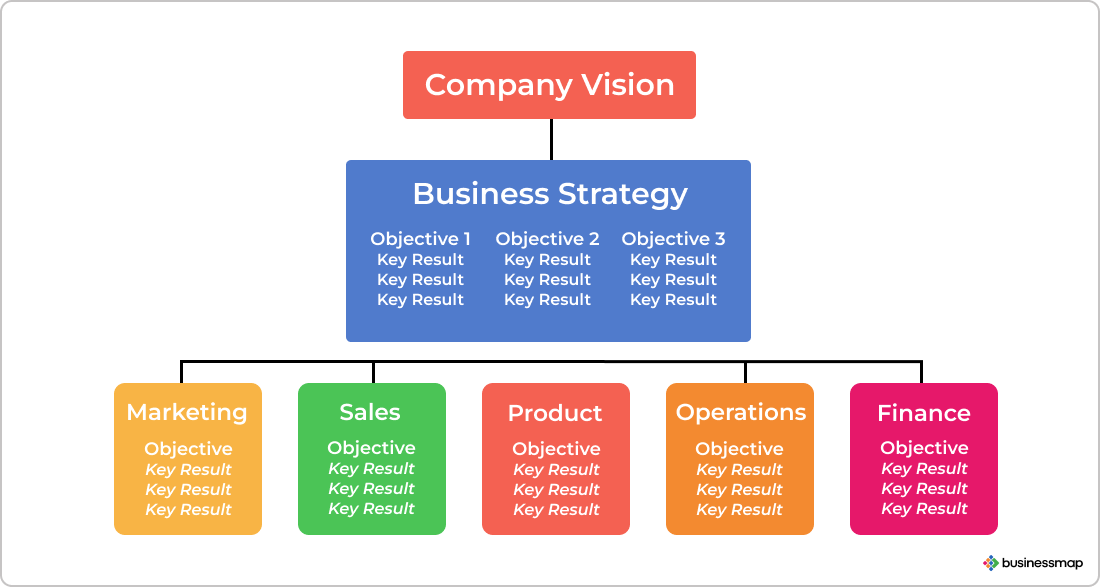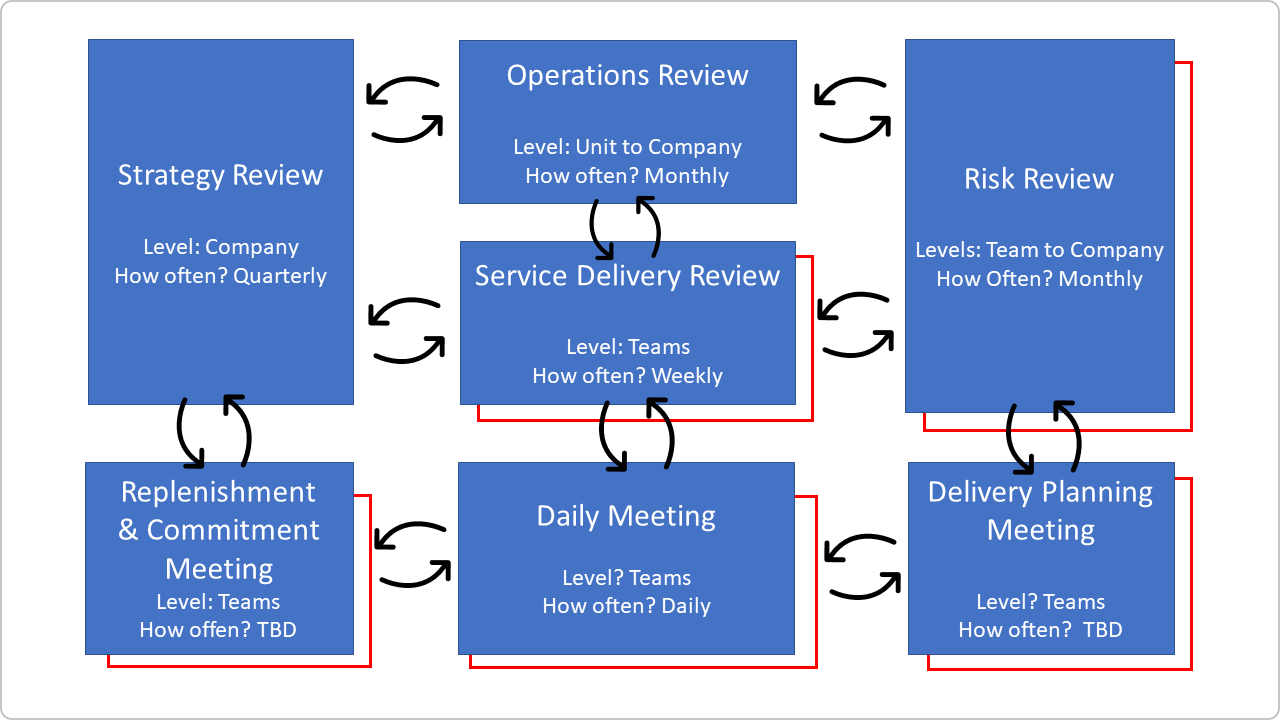OKRs, which stands for Objectives and Key Results, serve as a collaborative management approach aiding companies in setting goals. They foster alignment, sharpening focus, and transparency within the organization. Acting as a visual representation of the organization's top priorities, company OKRs provide a solid foundation for business strategies, departmental plans, and individual actions.
The efficacy of company OKRs lies in their ubiquity and strategic precision. In a landscape where complexity breeds inefficiency, it is imperative to recognize that company-level OKRs are not a panacea for all organizational challenges. Instead, they serve as a strategic filter, distilling the myriad of aspirations into a focused roadmap for collective success.
In this article, we delve into the essence of company OKRs, unraveling their transformative potential while navigating the pitfalls amidst misalignment. By understanding the complexity of crafting and implementing company OKRs, organizations can transcend the barriers of ambiguity and discord, leading to sustained growth and excellence.
Why Do Company OKRs Matter?
Often companies' efforts are focused in too many directions. A common reason for this is the lack of well-defined organizational goals to guide departments and teams. Usually, this results in decisions that have less or nothing to do with the company's objectives.
To avoid ending up in such a situation, company OKRs come into play. They represent the company's top priorities through strategic, aspirational, and measurable annual or quarterly goals. Once defined and transparent for everyone, company OKRs become the guiding star across the organization.
Alternatively said, company OKRs’ primary purpose is to help teams cooperate and work together toward the same goals while keeping everyone accountable for completing their team/department’s specific OKRs supporting the strategic objectives. This increases individual productivity and engagement while improving cross-functional and cross-departmental collaboration.
A company that fails to set proper top priorities and lacks team alignment is more likely to take too many directions and fail to reach its goals. As a result, departments and teams experience focus shifts, often delivering work that is not directly related to the ongoing priorities.
How OKRs Solve Company Level Challenges?
Through a lens of transparency and cross-functional collaboration, OKRs emerge as a potent solution for addressing company-level challenges. By offering clear visibility into company goals that cascade down to business units, departments, and individuals, OKRs pave the way for alignment from top to bottom.
This transparency prevents misalignment and fosters a cohesive understanding of shared objectives across the organization.
Moreover, OKRs facilitate cross-functional collaboration by aligning department initiatives with overarching company objectives. Each department's efforts contribute to achieving key results, driving collective advancement towards company-wide OKRs. This collaborative approach encourages teamwork and ensures that every team and individual is moving in concert towards common goals.
At the heart of OKRs lies a dual function: objectives provide directional guidance for departments, while key results offer measurable targets that motivate collaborative efforts.
How to Set Company-Wide OKRs?
To set objectives and key results on a company level, two essential prerequisites must be met.
First, everyone in your organization needs to understand that the OKRs concept is a goal-setting framework but also, it is a cultural shift that reaches every level of the organizational hierarchy.
Second, OKRs do not determine а company’s business goals or overall business strategy. Rather, it is presumed that these elements are already set and agreed upon. Setting OKRs can help support the strategy through specific and ambitious objectives measured by actionable key results.
In more practical terms, the OKRs framework's purpose is to support the organization’s efforts in reaching its strategic goals. Good company-level OKRs should be measurable too. Furthermore, they should be long-term and "broader" goals that allow teams to support them with their "shorter-term" OKRs.
 Aligning top-level and team-level OKRs to the company vision
Aligning top-level and team-level OKRs to the company vision
1. Collaborate to Define Company OKRs
When starting a new initiative of adopting the OKRs framework, many organizations tend to implement the top-down approach of defining and applying company OKRs throughout the organization. It is a common scenario because it is straightforward to roll out.
This process involves determining OKRs on a management level and pushing top-level key results as team objectives. However, it creates an environment typical for Waterfall project management where decisions and any further actions are taken by managers, and teams are left with little flexibility over their own decisions.
Instead, adopting OKRs successfully in your Agile organization requires significant collaboration. This is the best way to ensure that teams are aware of and aligned with the company’s ideas, goals, priorities, and vision.
To prevent the unwanted effect of surprises when there is a priority shift due to market changes, try to focus this communication in a top-down and bottom-up direction. Let teams determine specific team goals that they think would contribute to the company objectives and strategic vision.
While each approach has its pros and cons, we recommend aiming at aligning OKRs rather than cascading. Doing this allows you to achieve an OKR implementation at scale and be more agile when business priorities change.
2. Review Company OKRs Regularly
It is essential to review your OKRs regularly to keep track of their status and identify areas for improvement. A good way to check in on your company OKRs is by investing in appropriate OKR software.
It will help you determine if you’ve set the right goals, if you need to adjust your key results, what is your progress toward your goals, and what challenges you face. It is vital that your OKRs are updated regularly so that your organization can take appropriate actions to support the achievement of its goals.
A feedback loop gives you a clear picture of the issues you are trying to address in regard to your outcomes. Note that the timeline for these feedback meetings may not be the same for each organizational level. While you may set your strategic objectives once a year and have check-in meetings every quarter, it is different on the team level.
A good practice is to inspect your teams’ progress monthly or even weekly. This way, you can continuously improve problematic areas, which could ultimately have an effect on the outcomes at a company and strategic level.
 Feedback opportunity meetings as applied in Kanban
Feedback opportunity meetings as applied in Kanban
How Two of The Largest Organizations in the World Save Time & Money with OKRs?
Company OKRs Examples
Now let’s have a look at some specific examples illustrating what OKRs at a company level might look like in practice.
Example company OKR: Growth
Example 1:
| Objective |
Expand our presence in the South American market |
| Key Result 1 |
Increase the number of new customers from South America by 15% |
| Key Result 2 |
Increase monthly revenue from 120k to 250k |
| Key Result 3 |
Take part in 10 local events |
Example 2:
| Objective |
Enter the financial reporting market with a new product line |
| Key Result 1 |
Have 30% of customers use the new advanced financial analysis charts |
| Key Result 2 |
Increase the number of financial managers leads by 5% more |
| Key Result 3 |
Increase Revenue from $1mln to $5mln |
Example company OKR: Customer Satisfaction
| Objective |
Delight our customers base |
| Key Result 1 |
Achieve an NPS of 9 from our customers |
| Key Result 2 |
Customer support tickets are solved within 3 days or less |
| Key Result 3 |
Reduce average response time from 3h to 1h |
Example company OKR: Growth
| Objective |
Make this year the most profitable so far |
| Key Result 1 |
Increase monthly new sales revenue from 10k to 30k |
| Key Result 2 |
Increase the number of the advanced features package sold from 5k to 15k per month |
| Key Result 3 |
Keep annual churn rate below 5% |
Why Use OKR Software to Create Company OKRs
OKR software can enhance your company's performance by streamlining communication and collaboration across cross-functional teams.
OKR software fosters rapid, transparent, and feedback-driven interactions, facilitating efficient team coordination. Furthermore, it enables your company to stay aligned with evolving circumstances by enabling strategic adjustments through timely tracking of OKR progress.
How Businessmap Simplifies Company-Level OKRs?
With Businessmap OKR platform, your company can visualize your high-level goals/objectives and define their key results/outcomes. You can connect your goals to your kanban boards' actual work delivery processes.
With Businessmap’s OKR software, you can easily update the status of your outcomes and keep track of both your goals and daily work progress.
Our platform also gives you automatic projections about the progress of your outcomes/key results based on historical data.
Businessmap is the most flexible software
to align work with company goals
Related Articles





 Aligning top-level and team-level OKRs to the company vision
Aligning top-level and team-level OKRs to the company vision Feedback opportunity meetings as applied in Kanban
Feedback opportunity meetings as applied in Kanban


